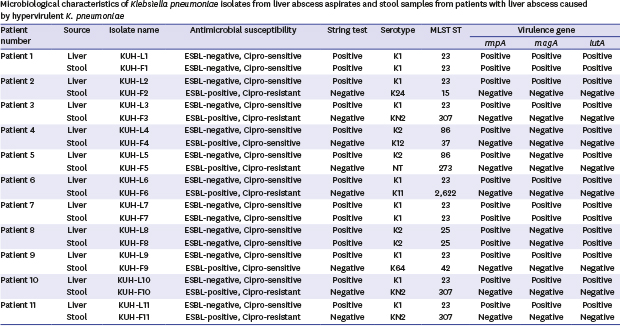1. Wang JH, Liu YC, Lee SS, Yen MY, Chen YS, Wang JH, et al. Primary liver abscess due to
Klebsiella pneumoniae in Taiwan. Clin Infect Dis. 1998; 26(6):1434–1438.

2. Qu TT, Zhou JC, Jiang Y, Shi KR, Li B, Shen P, et al. Clinical and microbiological characteristics of
Klebsiella pneumoniae liver abscess in East China. BMC Infect Dis. 2015; 15(1):161.



3. Chung DR, Lee SS, Lee HR, Kim HB, Choi HJ, Eom JS, et al. Emerging invasive liver abscess caused by K1 serotype
Klebsiella pneumoniae in Korea. J Infect. 2007; 54(6):578–583.

4. Siu LK, Yeh KM, Lin JC, Fung CP, Chang FY.
Klebsiella pneumoniae liver abscess: a new invasive syndrome. Lancet Infect Dis. 2012; 12(11):881–887.

5. Lin JC, Chang FY, Fung CP, Xu JZ, Cheng HP, Wang JJ, et al. High prevalence of phagocytic-resistant capsular serotypes of
Klebsiella pneumoniae in liver abscess. Microbes Infect. 2004; 6(13):1191–1198.

6. Jun JB.
Klebsiella pneumoniae liver abscess. Infect Chemother. 2018; 50(3):210–218.


7. Lin YT, Siu LK, Lin JC, Chen TL, Tseng CP, Yeh KM, et al. Seroepidemiology of Klebsiella pneumoniae colonizing the intestinal tract of healthy Chinese and overseas Chinese adults in Asian countries. BMC Microbiol. 2012; 12(1):13.
8. Chung DR, Lee H, Park MH, Jung SI, Chang HH, Kim YS, et al. Fecal carriage of serotype K1 Klebsiella pneumoniae ST23 strains closely related to liver abscess isolates in Koreans living in Korea. Eur J Clin Microbiol Infect Dis. 2012; 31(4):481–486.
9. Siu LK, Fung CP, Chang FY, Lee N, Yeh KM, Koh TH, et al. Molecular typing and virulence analysis of serotype K1
Klebsiella pneumoniae strains isolated from liver abscess patients and stool samples from noninfectious subjects in Hong Kong, Singapore, and Taiwan. J Clin Microbiol. 2011; 49(11):3761–3765.


10. Fung CP, Lin YT, Lin JC, Chen TL, Yeh KM, Chang FY, et al.
Klebsiella pneumoniae in gastrointestinal tract and pyogenic liver abscess. Emerg Infect Dis. 2012; 18(8):1322–1325.



11. Clinical and Laboratory Standards Institute. Performance Standards for Antimicrobial Disk Susceptibility Tests; Approved Standard – Twelfth Edition. CLSI Document M02-A12. Wayne, PA: Clinical and Laboratory Standards Institute;2015.
12. Shon AS, Bajwa RP, Russo TA. Hypervirulent (hypermucoviscous)
Klebsiella pneumoniae: a new and dangerous breed. Virulence. 2013; 4(2):107–118.


13. Fang CT, Lai SY, Yi WC, Hsueh PR, Liu KL, Chang SC.
Klebsiella pneumoniae genotype K1: an emerging pathogen that causes septic ocular or central nervous system complications from pyogenic liver abscess. Clin Infect Dis. 2007; 45(3):284–293.

14. Brisse S, Passet V, Haugaard AB, Babosan A, Kassis-Chikhani N, Struve C, et al.
wzi Gene sequencing, a rapid method for determination of capsular type for
Klebsiella strains. J Clin Microbiol. 2013; 51(12):4073–4078.


15. Diancourt L, Passet V, Verhoef J, Grimont PA, Brisse S. Multilocus sequence typing of
Klebsiella pneumoniae nosocomial isolates. J Clin Microbiol. 2005; 43(8):4178–4182.


16. Letunic I, Bork P. Interactive tree of life (iTOL) v3: an online tool for the display and annotation of phylogenetic and other trees. Nucleic Acids Res. 2016; 44(W1):W242–W245.

17. Yu WL, Ko WC, Cheng KC, Lee HC, Ke DS, Lee CC, et al. Association between rmpA and magA genes and clinical syndromes caused by Klebsiella pneumoniae in Taiwan. Clin Infect Dis. 2006; 42(10):1351–1358.
18. Compain F, Babosan A, Brisse S, Genel N, Audo J, Ailloud F, et al. Multiplex PCR for detection of seven virulence factors and K1/K2 capsular serotypes of
Klebsiella pneumoniae. J Clin Microbiol. 2014; 52(12):4377–4380.


19. Liao CH, Huang YT, Chang CY, Hsu HS, Hsueh PR. Capsular serotypes and multilocus sequence types of bacteremic
Klebsiella pneumoniae isolates associated with different types of infections. Eur J Clin Microbiol Infect Dis. 2014; 33(3):365–369.

20. Jeong SJ, Yoon SS, Han SH, Yong DE, Kim CO, Kim JM. Evaluation of humoral immune response to nosocomial pathogen and functional status in elderly patients with sepsis. Arch Gerontol Geriatr. 2014; 58(1):10–14.


21. Liu C, Guo J. Hypervirulent
Klebsiella pneumoniae (hypermucoviscous and aerobactin positive) infection over 6 years in the elderly in China: antimicrobial resistance patterns, molecular epidemiology and risk factor. Ann Clin Microbiol Antimicrob. 2019; 18(1):4.



22. Zhang X, Wang L, Li R, Hou P, Zhang Y, Fang M, et al. Presence and characterization of
Klebsiella pneumoniae from the intestinal tract of diarrhoea patients. Lett Appl Microbiol. 2018; 66(6):514–522.

24. Zhang Y, Zhao C, Wang Q, Wang X, Chen H, Li H, et al. High prevalence of hypervirulent
Klebsiella pneumoniae infection in China: geographic distribution, clinical characteristics, and antimicrobial resistance. Antimicrob Agents Chemother. 2016; 60(10):6115–6120.









 PDF
PDF Citation
Citation Print
Print





 XML Download
XML Download